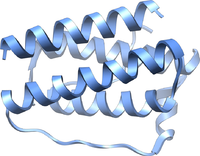
Photo from wikipedia
Epidemiological and clinical evidences have shown that bone mineral density (BMD) has a close relationship with breast cancer (BC). They might potentially have a shared genetic basis. By incorporating information… Click to show full abstract
Epidemiological and clinical evidences have shown that bone mineral density (BMD) has a close relationship with breast cancer (BC). They might potentially have a shared genetic basis. By incorporating information about these pleiotropic effects, we may be able to explore more of the traits’ total heritability. We applied a recently developed conditional false discovery rate (cFDR) method to the summary statistics from two independent GWASs to identify the potential pleiotropic genetic variants for BMD and BC. By jointly analyzing two large independent GWASs of BMD and BC, we found strong pleiotropic enrichment between them and identified 102 single-nucleotide polymorphisms (SNPs) in BMD and 192 SNPs in BC with cFDR < 0.05, including 230 SNPs that might have been overlooked by the standard GWAS analysis. cFDR-significant genes were enriched in GO terms and KEGG pathways which were crucial to bone metabolism and/or BC pathology (adjP < 0.05). Some cFDR-significant genes were partially validated in the gene expressional validation assay. Strong interactions were found between proteins produced by cFDR-significant genes in the context of biological mechanism of bone metabolism and/or BC etiology. Totally, we identified 7 pleiotropic SNPs that were associated with both BMD and BC (conjunction cFDR < 0.05); CCDC170, ESR1, RANKL, CPED1, and MEOX1 might play important roles in the pleiotropy of BMD and BC. Our study highlighted the significant pleiotropy between BMD and BC and shed novel insight into trait-specific as well as the potentially shared genetic architecture for both BMD and BC.
Journal Title: Calcified Tissue International
Year Published: 2017
Link to full text (if available)
Share on Social Media: Sign Up to like & get
recommendations!